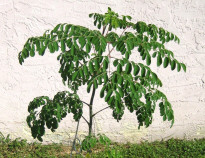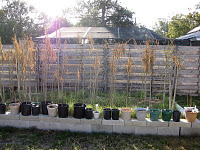"Hi! I'm Morey, the Moringa Oleifera
Seed! My trees do not like to grow in cold weather!"
Because we are a tropical tree, we need a lot of sunlight and warmth. Don't
keep us out
in the cold!
If you are not able
to grow Moringa, due to the climate
in your area, you can still enjoy
many of
the benefits of Moringa, by
adding Moringa
Leaf Powder to
your diet!
Check out the
"HOW-TO"
menu at the
right, for how
to eat Moringa
Leaf Powder.
How to Grow Moringa in Cold Climates
It can be done, but it will take some effort on your part.
Please bear in mind that Moringas prefer
a tropical climate!
Moringa trees love warmth, sunlight, and some water. If you live in an area where the temperatures get below 32° F, you can still grow Moringa, but it will most likely not survive unless you take some precautions. If the root freezes, the tree will die. Click here to read about ours during a FL winter...
1 - The BEST option, is to grow it in a greenhouse-type setup, where the tree will have protection from the cold. They will not require as much water, as in the summer, so do not overwater the trees.
2 - Another way to insure your Moringa's survival, is to plant it in a large potting container, and seek out a friendly greenhouse in your area, to "winter" it for you.
3 - You can plant your Moringa seeds in large containers, and bring the seedlings inside during the cold months - HOWEVER - they will need plant lights on them, warmth around them, and some water.
4 - Moringa can be grow as an annual. You can start them indoors, and put them outside when the weather is about 70° F. Follow the "How-To" link on the right hand side of this page, for Prune Moringa Trees, to get the most leaves from your Moringa trees.
5 - Large, outdoor Christmas tree lights strung around the trees will give them some warmth. We did that one year, and also ran some lawn sprinklers on them, 4 times a day for about 3 minutes. That helped keep the Moringas warm, as the water evaporated - creating warmth for the trees.
6 - Some of our customers have bundled straw and hay around the trunks of their Moringa trees. That helps, but will not keep them alive during a rough winter, when the ground freezes.
7 - You can take cuttings from your Moringa trees, too, to propagate them for the following year. Cut them at least 15 inches long, with a 1 inch to 2 inch woody diameter, and put them into soil in potting containers. Keep them watered so they are moist, but not soggy, and keep them inside where it is warm. They will still need plant lights on them, but you should see new leaf buds sprouting within about 3 weeks.
Here are some of
our poor trees, planted in a
raised bed.
Over the winter,
they lost all
of their leaves,
and looked
like dead
sticks. We were
hearsick!
It was a pathetic sight to see, but
as soon as our Florida weather warmed up, they came back in
full force, and
I had a hard time keeping up with them!
Just remember: Moringa is
a tropical tree!
I Love Moringa
the fast-growing, nutritious, delicious gift from God
This page was last updated: August 29, 2022
HOW TO:
More About --- Moringa

